Bug
Detection
They bite, suck, even
try to rasp your plants to death. How to work out which bug is doing
what.

With Ruud Kleinpaste
Being a plant doctor
is not easy. In our gardens we're confronted with a whole range
of damage patterns on our plants. There's holes in leaves, there's
grey leaves, there's sooty mould and honeydew. And who does what?
Forget about the classification of insects. I divide my pests into
three categories; the chewers, the suckers and the raspers. And
it all depends on what their mouthparts look like.
CHEWERS
A chewer makes large
holes in leaves. It takes plant material away, and that's the key
to chewing insects. They remove leaf material and digest it.
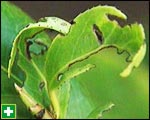 On
this camellia bush we have very specific chewing damage. It's called
'shot holes' because there's tiny holes on the leaf. It's caused
by bronze beetle in springtime, but this damage was caused almost
a year ago. You can see that because the edges are totally brown,
and that means that it's old damage. On
this camellia bush we have very specific chewing damage. It's called
'shot holes' because there's tiny holes on the leaf. It's caused
by bronze beetle in springtime, but this damage was caused almost
a year ago. You can see that because the edges are totally brown,
and that means that it's old damage.
The question is, what
do chewers actually do to the health of the plant? What are the
consequences?
First of all, they are
just like my pair of secateurs — selective pruners, and they
take away bits of green material. Any plant that is well-established
— think of your roses — will grow back copious amounts
of leaves after pruning. We take 80% of our roses off in winter,
so why wouldn't a plant be able to stand that? It will, don't make
any mistakes. But the thing is, selective pruning can sometimes
disfigure a plant a little bit and you might need some control.
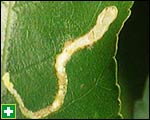 Chewers
like caterpillars, beetles, weevils, katydids and earwigs can be
easily controlled with chemicals like Maldison, Carbaryl and Mavrik
or, organically, you can control them with Pyrethrum or Derris Dust. Chewers
like caterpillars, beetles, weevils, katydids and earwigs can be
easily controlled with chemicals like Maldison, Carbaryl and Mavrik
or, organically, you can control them with Pyrethrum or Derris Dust.
For slugs and snails,
you can use snail bait, or what about beer traps or hand-picking?
Leaf miners are protected
inside the leaf and therefore need systemic insecticides, such as
Orthene or Target.
SUCKERS
Think of a digger. The
way it drills into the soil is similar to the way suckers drill
into plants. If the digger were to hit a water main, it would be
exactly the way the sucking insects find their food. Suckers stick
their mouthparts into the phloem of the plant and extract the sweet
plant sap within.
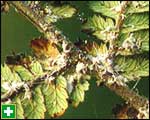 Suckers
excrete most of that sweet stuff as honeydew, which is eagerly harvested
by ants. If you see a heap of ants going all over your plants, you
know that a sucker must be at work, such as aphids on the underside
of the leaves. Suckers
excrete most of that sweet stuff as honeydew, which is eagerly harvested
by ants. If you see a heap of ants going all over your plants, you
know that a sucker must be at work, such as aphids on the underside
of the leaves.
Excess honeydew is a
brilliant breeding ground for sooty mould. Here's a good infestation
of mealy bug, causing sooty mould all over the place, including
the bricks.
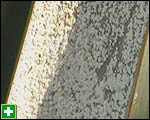 This
is a good example of massive numbers of suckers hammering the flax.
They are scale insects and they are nicking all the sweet sap, causing
local deficiencies in the leaves (discolouring of leaves). You see,
that sweet sap is normally used for plant growth, including leaves,
and the flax is suffering. This
is a good example of massive numbers of suckers hammering the flax.
They are scale insects and they are nicking all the sweet sap, causing
local deficiencies in the leaves (discolouring of leaves). You see,
that sweet sap is normally used for plant growth, including leaves,
and the flax is suffering.
Most suckers like aphids,
scale insects, mealy bug, passionvine hopper, whitefly and green
vegetable bug are like flying hypodermic needles, and that means
they can spread diseases, especially viruses. That can be very serious
for the health of the plant.
General chemical control
of sucking insects would be systemic insecticides such as Orthene
or Target. With scale insects and mealy bugs, use mineral oil or
mineral oil mixed with insecticide. Organic control of most suckers
can be achieved with oil, fatty acids or Pyrethrum.
RASPERS
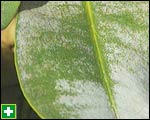 Back
to the digger again. The way its scraping blade works the soil surface
resembles a rasping creepy-crawly attacking the outer layer of the
cells on the leaf. Back
to the digger again. The way its scraping blade works the soil surface
resembles a rasping creepy-crawly attacking the outer layer of the
cells on the leaf.
Raspers are really minute
invertebrates with mouthparts not unlike a scalpel blade, or buck
teeth. They scrape the top layer, or epidermal cells, of leaves
and lap up their contents. The cells then fill with air and that
causes a discoloration — silvering, bronzing or yellow stippling.
In this case, this rhododendron has got silvering leaves caused
by thrips.
Thrips on azalea tend
to cause a distinct bronzing effect. The thrips happily live on
the underside of the leaves, as long as it's out of the sun.
Two-spotted spider mites
are also raspers. They love to damage cells in patches, causing
yellow stippling. Spider mites usually operate on the underside
of the leaf and love to surround themselves with lots of fine silk
webbing.
High population densities
of thrips and mites can cause a real mess. More often than not,
they can debilitate their host plant as well, so control is usually
needed.
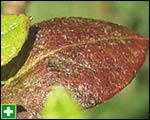 Thrips
are insects and will be killed by insecticides such as Maldison,
Mavrik or Orthene or, organically, by fatty acids or Neem oil. Thrips
are insects and will be killed by insecticides such as Maldison,
Mavrik or Orthene or, organically, by fatty acids or Neem oil.
Mites are not insects
and regular insecticides often don't work on them. You'll need a
miticide, such as Dicofol or, organically, use fatty acids, mineral
oils or simply mist the leaves with water.
So, next time you see
some leaf damage on your plant, try to classify it as either a chewer,
a sucker or a rasper, because if you know who did it, it is easy
to get the right control method.

Reproduced
with permission from NZOOM Home and Garden content,
from the previous
website of 
The views expressed here are not necessarily those of the RNZIH
 |
|
HOME
AND GARDEN |
|
|
More
Garden Articles
|